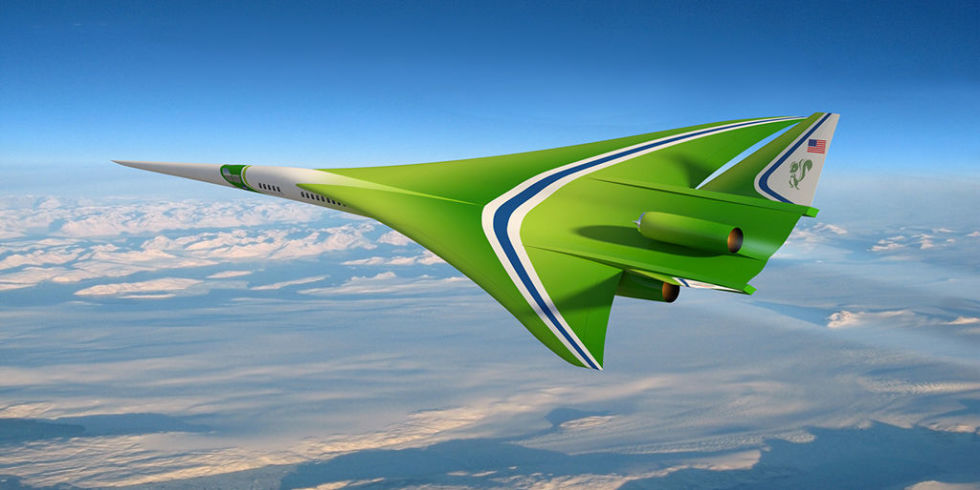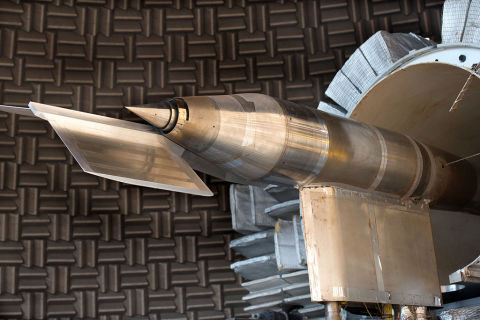NASA and Lockheed Martin are designing an experimental X-plane called the Quiet Supersonic Technology
(QueSST) demonstrator aircraft that they hope to fly for the first time
in 2019. The program is intended to solve one of the biggest problems
with commercial supersonic flight: noise, and specifically the noise a
plane makes when it breaks the sound barrier. Even if a company
developed a reliable supersonic passenger aircraft,
regulations would allow that plane to break the sound barrier only over
the ocean, preventing the JFK to LAX flight of your dreams.
Lockheed's design of the QueSST,
the LM1044, is intended to prevent the air pressure waves that build up
on the airframe from coalescing into one large shockwave. Such a design
has the potential to break the sound barrier with a low rumble of small
sonic booms rather than the dramatic clap of a large one.
But
the sonic boom isn't the only noise problem on a supersonic jet. The
engines themselves are incredibly loud—too loud for a commercial
airport, especially as traditional airliners get quieter and the
industry lowers noise limits. The Concorde itself was much louder than
the subsonic jets of the late 1970s, and the aviation industry isn't
willing to accept that kind of racket anymore.
So
NASA is conducting ground tests at its Glenn Research Center on an
engine nozzle that would reduce the exhaust noise level to below
industry limits, according to Aviation Week. Noise limits for aircraft differ depending on maximum takeoff mass (MTOM), but generally speaking the cutoff is somewhere between 250 and 300 EPNdB, or Effective Perceived Noise decibels.
The International Civil Aviation Organization (ICAO) plans to reduce
those limits even further in 2017, though the noise levels that NASA is
shooting for would still be quiet enough. James Bridges, technical lead
for acoustics within NASA's Commercial Supersonics Technology project,
told Aviation Week:
Our technical challenge is to demonstrate the ability to design a commercial aircraft for supersonic cruise flight and make it meet the same noise standards as everything that is currently flying and will fly for some time. That is a big challenge because traditionally airport noise has been one of the main stumbling blocks for supersonic commercial aircraft.
The
ideal engine for the QueSST is a variable-cycle engine, or three-stream
turbofan. Variable-cycle engines divert air entering the engine into
three pathways rather than two: the core and the bypass duct that you
find on traditional turbofans plus an additional outer flowpath. The
advantage to the three-stream design is that you can manipulate when the
airstreams combine with the exhaust. For example, a high bypass ratio can be used during takeoff to reduce noise, but the pilot could change the ratio once in flight for maximum cruise efficiency.
The engine nozzle being tested at Glenn is an inverted velocity profile
(IVP) nozzle developed by GE. The design mixes the two primary airflows
from the core and main fan internally before releasing them as exhaust.
The third airflow from the tip fan, traveling at a lower velocity, is
released within the primary exhaust jet rather than outside it, as is
the case with conventional engine nozzles.
With
ground testing underway for the engine nozzle to reduce airport noise,
and wind-tunnel testing with a model of the aircraft planned for the end
of the year, we might just see the QueSST's first flight before the
decade is out.
Source: NASA via Aviation Week




Δεν υπάρχουν σχόλια:
Δημοσίευση σχολίου